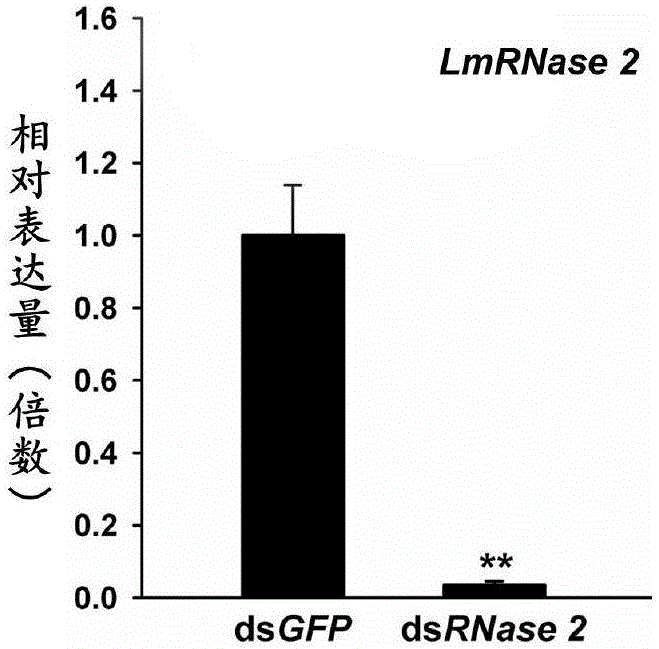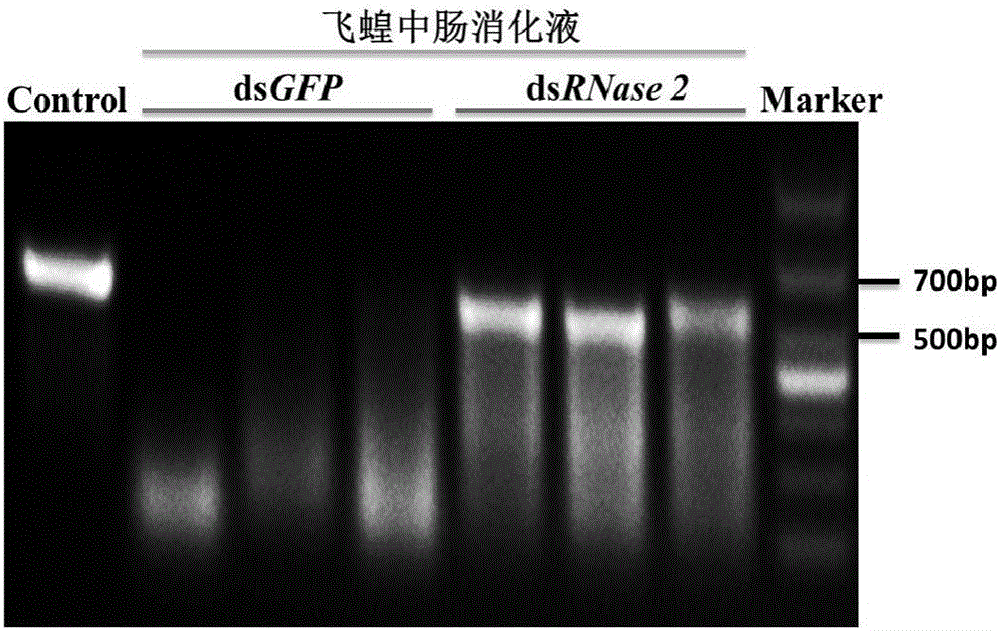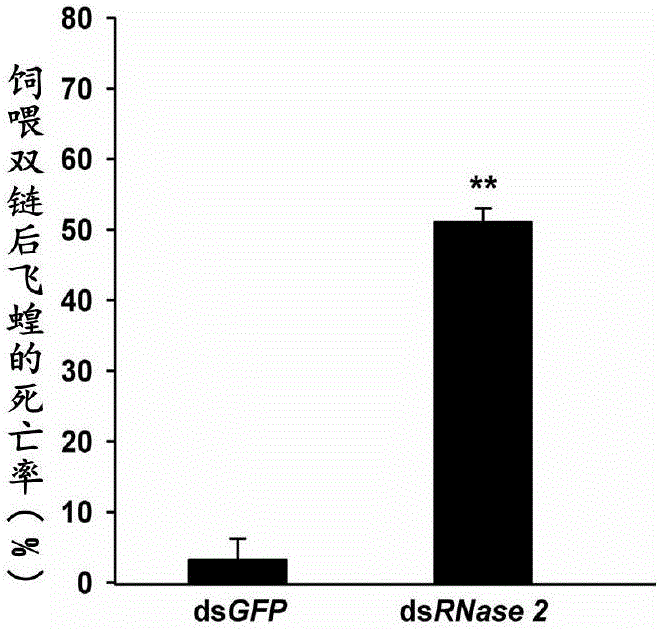Application of migratory locust intestinal tract RNase gene 2 to pest prevention and control
A hydrolytic enzyme and nucleic acid technology, applied in hydrolytic enzymes, applications, genetic engineering, etc., can solve the problems of restricting the application of insect-resistant dsRNA, feeding dsRNA can not achieve the desired effect, etc.
- Summary
- Abstract
- Description
- Claims
- Application Information
AI Technical Summary
Problems solved by technology
Method used
Image
Examples
Embodiment 1
[0012] Example 1: Acquisition of full-length cDNA sequence and amino acid sequence analysis of migratory locust RNase 2
[0013] 1. Obtaining the full-length cDNA sequence of migratory locust RNase 2
[0014] Based on the transcriptome database of migratory locusts, the Unigene was searched, and after NCBI Blastx analysis, it was confirmed that a fragment of RNase 2 of migratory locusts was obtained. The fragment was analyzed with GeneDoc software, and primer premier5.0 software was used to design the upstream primer ACGATGGCCTCCCTACCGCT (SEQ ID NO: 6) and the downstream primer TGTTTCACATCTGAGACGGTTAG (SEQ ID NO: 7), provided by Sangon Bioengineering (Shanghai) Co., Ltd. synthesis.
[0015] Select well-developed 5th instar migratory locust nymphs with equal size and half male and half sexes, and quickly dissect the midgut under a stereomicroscope, and freeze them in liquid nitrogen. RNA was extracted according to the TaKaRa Trizol kit. The extracted RNA was reverse-transcri...
Embodiment 2
[0018] Embodiment 2: the dsRNA of synthetic migratory locust RNase 2
[0019] 1. Design dsRNA primers of migratory locust RNase 2
[0020] Based on the migratory locust RNase 2 sequence, it was designed using primer premier5.0 software. dsRNA primers were designed, the sequences of which were taatacgactcactatagggGTCGGCTCCGACTTCTACAC (SEQ ID NO: 4) and taatacgactcactatagggAGCTCCGTCTCGACATTGTT (SEQ ID NO: 5) (the part in italics is the T7 promoter). All primers were synthesized by Sangon Bioengineering (Shanghai) Co., Ltd.
[0021] 2. Preparation of templates for the synthesis of migratory locust RNase 2 dsRNA
[0022] The above-mentioned preserved RNase 2 plasmid was used as a template, and a PCR amplification was performed with a primer with a T7 promoter sequence synthesized to obtain a fragment with a length of 540 bp, the nucleotide sequence of which was SEQ ID NO:3. The PCR product was purified with Gel Extroaction Kit (Omega), and then quantified with NaNoDrop 2000 (Th...
Embodiment 3
[0025] Example 3: The influence of dsRNA of migratory locust RNase 2 on the stability and interference efficiency of dsRNA introduced by feeding method.
[0026]1. Injection of specific dsRNA
[0027] A total of 39 well-developed, uniformly sized, male and female 5th-instar nymphs were selected for the experiment. Gently inject 4 μl (10 μg) of synthetic RNase 2 dsRNA into the flank between the second and third abdominal segments of the nymph using a 25 μl microsyringe. At the same time, 39 nymphs were selected as the control group, and the dsRNA of GFP was injected into the control group with the same volume and concentration. The injected migratory locusts were reared in a 30°C constant temperature biochemical incubator (light:dark time=14h:10h, temperature 30±2°C, humidity 60%), and fed fresh wheat seedlings and wheat bran every day.
[0028] 2. Detection of the silencing efficiency of migratory locust RNase 2 and the influence of midgut digestive juice on the integrity of...
PUM
| Property | Measurement | Unit |
|---|---|---|
| molecular weight | aaaaa | aaaaa |
Abstract
Description
Claims
Application Information
 Login to View More
Login to View More - R&D
- Intellectual Property
- Life Sciences
- Materials
- Tech Scout
- Unparalleled Data Quality
- Higher Quality Content
- 60% Fewer Hallucinations
Browse by: Latest US Patents, China's latest patents, Technical Efficacy Thesaurus, Application Domain, Technology Topic, Popular Technical Reports.
© 2025 PatSnap. All rights reserved.Legal|Privacy policy|Modern Slavery Act Transparency Statement|Sitemap|About US| Contact US: help@patsnap.com



